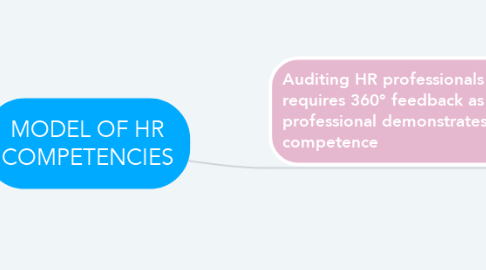
1. Auditing HR professionals requires 360° feedback as a HR professional demonstrates competence
1.1. it is important to carry out two levels to have a productive and effective human resources competency model.
1.1.1. First: conceptually, an HR competence model should identify the knowledge, skills, and abilities required to be a successful HR professional.
1.1.2. Second: behaviorally, an HR competence model should identify the behaviors required to demonstrate the trait.
1.2. Steps to define the performance in human resources management
1.2.1. Step 1: Model of human resources competences
1.2.1.1. There are many models of what makes a human resources professional successful, but most are intertwined around four groups of competencies: Knowledge of business. Knowledge of human resources Knowledge of change / process and personal credibility
1.2.2. Step 2: Collect data using the model
1.2.2.1. Once the model has been identified, data can be collected to assess to what extent a human resources professional demonstrates the competencies acquired. The data may also come from quantitative assessments of the features included in the scheduled survey form. The quantitative evaluations are more uniform and systematic, but are limited to the questions asked in the survey. The data can also come from focus groups or interviews in which individuals talk about the extent to which human resources professionals demonstrate competence.
1.2.3. Step 3: Summarize data and feedback to human resources professionals.
1.2.3.1. The data collected should be summarized to identify the statistical means to be used, with this an analysis of indicators is made to measure their strengths and devilities. Feedback on HR competencies (an important step) should be done in a way that does not violate data providers (for example, by violating confidences or misrepresenting data) and at the same time being sensitive to the recipient of the data. data (eg do not overwhelm the receiver).
1.2.4. Step 4: Create action plans.
1.2.4.1. Action plans can be created in two levels: At the institutional level. On an individual level An action plan can provide a set of solutions adapted from development experiences, including task assignments, readings and training opportunities.
1.2.5. Step 5: Continuous improvement
1.2.5.1. you must acquire more knowledge, get feedback, not be oblivious to the change. The creation of a learning environment for human resource professionals is evident when they invest annually in their own development, requesting comments on their performance, attending conferences, comparative evaluation practices, reading and keeping abreast of innovations in their areas of expertise.
